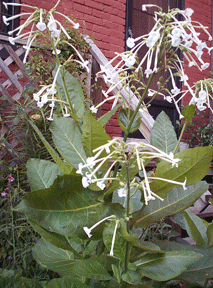Abracadabra

Have you ever noticed that most garden problems can be solved by the simple expedient of cutting them off? This works with hair, too. I mentioned Tracy DiSabato-Aust’s seminal work on perennials a couple posts ago; the main lessons I learned from her book were the essential strategies of pruning, deadheading, and cutting stuff back to the ground. This will not be news to most plant geeks, I know, yet it always gratifies me to see the tiny miracles that can result.
At this very moment, for example, I have reblooms on a sidalcea (barely visible behind the giant nicotiana sylvestris, above, which greatly benefits from daily deadheading). Ok, sidalcea, big deal. But I also have rebloom on several columbine (aquilegia) plants, and I think columbines in August are kind of cool. I have had additional success with radical pruning of several midge-beleaguered roses. The new growth, when it comes, seems more resistant. I now cut roses way back when I cut them, not just to the first 5-leaf node. Other plants that respond very well to constant yanking, plucking, and shearing are lamium, dicentra (the ever-blooming type), and many hardy geraniums.
There is great pleasure in ruthlessly snipping and slicing your way through the garden, and it’s a perfect activity to accompany wine-drinking. Not too much skill is needed and there’s no kneeling or digging. The other advantage of using these mechanical means of getting rid of bad stuff—rather than chemical means—is that nothing untoward gets in your glass.

Comments
I got some good regrowth on snapdragons and my mon lam plant after pruning.It helps regenerate the plant for a second burst.
I have written a post for you on my blog, in response to your literary post..
I always use my Spiegelaus in the garden, breakage be damned. The setting calls for at least that level of quality. I've never broken one out there, actually. Can't say the same for guests.